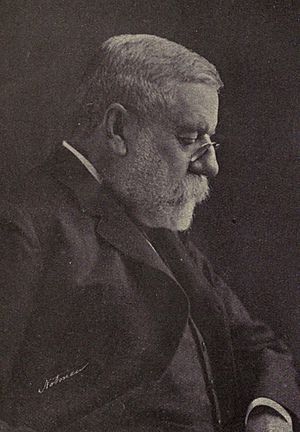Charles Sprague Sargent facts for kids
Charles Sprague Sargent (born April 24, 1841 – died March 22, 1927) was an American botanist. A botanist is a scientist who studies plants. In 1872, he became the first director of the Arnold Arboretum at Harvard University in Boston, Massachusetts. He stayed in this important job until he passed away. Charles Sargent wrote many books about plants. When you see the name Sarg. next to a plant's scientific name, it means he was the one who identified it!
Contents
Early Life and Education
Charles Sargent was born into a wealthy family in Boston. He grew up on his father's large estate in Brookline, Massachusetts. This estate was about 130 acres, which is a lot of land!
He went to Harvard College and studied Biology. He graduated in 1862. Later that year, Sargent joined the Union Army during the American Civil War. He served in Louisiana and finished his military service in 1865. After the war, he spent three years traveling around Europe and Asia.
Starting His Career
When Charles Sargent came back home, he began managing his family's estate, called "Holmlea." He became very interested in growing plants and designing landscapes. He wanted his family's land to look like a natural forest, not a formal garden. He created winding paths and planted many trees and shrubs.
In 1872, Harvard University decided to create a special garden for trees and shrubs, called an arboretum. Professor Francis Parkman, who taught about gardening at Harvard, suggested Sargent for the job. By the end of 1872, Charles Sargent became the first Director of the Arnold Arboretum. He also directed the Botanic Garden in Cambridge.
Family Life
On November 26, 1873, Charles Sargent married Mary Allen Robeson. They had five children together: two sons and three daughters.
Later Career and Achievements
Charles Sargent was a very focused person. He spent most of his time working at the Arnold Arboretum. He worked closely with Frederick Law Olmsted, a famous landscape architect. Together, they planned the roads and plant collections for the arboretum. They even helped choose trees for Commonwealth Avenue in Boston.
Sargent became an expert in dendrology, which is the study of trees. He wrote many books and articles about trees. He also played a big part in protecting American forests. He was a member of the National Forest Commission from 1896 to 1897. This group advised President Grover Cleveland on creating national forest reserves. These reserves helped protect millions of acres of forests.
Sargent believed that forests should be kept as "wilderness," meaning they should be left in their natural state. He disagreed with another forest expert, Gifford Pinchot, who thought forests should be used for things like cutting timber in a careful, sustainable way. Sargent also led a group in 1885 that worked to protect the Adirondack forests.
In 1879, Sargent became a professor at Harvard, teaching about trees. He also helped plan a special collection of North American woods for the American Museum of Natural History in New York City in 1880.
He was also involved in publishing. In 1888, he became the editor of a weekly magazine called Garden and Forest. This magazine was about gardening, landscape design, and forestry. Later, in 1919, he became the editor-in-chief of the Journal of the Arnold Arboretum.
For his important work, he received the Veitch Memorial Medal from the Royal Horticultural Society in 1896.
Legacy
Charles Sargent passed away in 1927. At a special Arbor Day ceremony held in his memory, Massachusetts Governor Fuller planted a white spruce tree. Governor Fuller said that Professor Sargent knew more about trees than anyone else. He also said that Sargent did a lot to protect trees from harm and helped people understand how important trees are to our country's beauty and wealth.
See also



